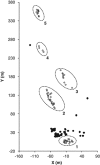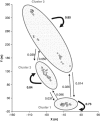Metapopulation structure and fine-scaled genetic structuring in crop-wild hybrid weed beets
- PMID: 21448229
- PMCID: PMC3199920
- DOI: 10.1038/hdy.2011.23
Metapopulation structure and fine-scaled genetic structuring in crop-wild hybrid weed beets
Abstract
This study explores the microspatial and temporal genetic variation in crop-wild hybrid weed beets that emerged from the seed bank in a cultivated field surveyed over two successive years. We demonstrate the occurrence of demes highly genetically differentiated, kin-structured, characterized by moderate effective population sizes, differing in propensity for selfing, and arising from nonrandom genetic subsets of the seed bank. Only one deme identified in the first survey year significantly contributed to the weed beets that emerged in the second year. Spatial structuring appears to be primarily due to gravity seed dispersal and limited pollen flow among weed beet demes. Within each genetic cluster identified by Bayesian assignments and multivariate analyses, F(IS) estimates and level of biparental inbreeding--revealed by progeny analyses--dropped to non-significant values. This suggests that random mating occurs at the scale of genetically distinct demes over a very short scale. Our results highlight the need to carefully depict genetic discontinuities in weed species, when attempting to describe their local genetic neighborhoods within which genetic drift and selective processes occur.
Figures





Similar articles
-
Long distance pollen-mediated gene flow at a landscape level: the weed beet as a case study.Mol Ecol. 2007 Sep;16(18):3801-13. doi: 10.1111/j.1365-294X.2007.03448.x. Mol Ecol. 2007. PMID: 17850547
-
Fine-scale geographical structure of genetic diversity in inland wild beet populations.Mol Ecol. 2009 Aug;18(15):3201-15. doi: 10.1111/j.1365-294X.2009.04279.x. Epub 2009 Jul 14. Mol Ecol. 2009. PMID: 19627487
-
Nuclear and cytoplasmic genetic diversity in weed beet and sugar beet accessions compared to wild relatives: new insights into the genetic relationships within the Beta vulgaris complex species.Theor Appl Genet. 2008 May;116(8):1063-77. doi: 10.1007/s00122-008-0735-1. Theor Appl Genet. 2008. PMID: 18335202
-
Populations of weedy crop-wild hybrid beets show contrasting variation in mating system and population genetic structure.Evol Appl. 2010 May;3(3):305-18. doi: 10.1111/j.1752-4571.2010.00121.x. Epub 2010 Feb 18. Evol Appl. 2010. PMID: 25567926 Free PMC article.
-
Environmental implications of gene flow from sugar beet to wild beet--current status and future research needs.Environ Biosafety Res. 2003 Apr-Jun;2(2):105-15. doi: 10.1051/ebr:2003006. Environ Biosafety Res. 2003. PMID: 15612276 Review.
Cited by
-
The red queen in the corn: agricultural weeds as models of rapid adaptive evolution.Heredity (Edinb). 2013 Apr;110(4):303-11. doi: 10.1038/hdy.2012.104. Epub 2012 Nov 28. Heredity (Edinb). 2013. PMID: 23188175 Free PMC article. Review.
-
Potential of SNP markers for the characterization of Brazilian cassava germplasm.Theor Appl Genet. 2014 Jun;127(6):1423-40. doi: 10.1007/s00122-014-2309-8. Epub 2014 Apr 16. Theor Appl Genet. 2014. PMID: 24737135
-
Spatial genetic structure in Beta vulgaris subsp. maritima and Beta macrocarpa reveals the effect of contrasting mating system, influence of marine currents, and footprints of postglacial recolonization routes.Ecol Evol. 2014 May;4(10):1828-52. doi: 10.1002/ece3.1061. Epub 2014 Apr 18. Ecol Evol. 2014. PMID: 24963380 Free PMC article.
References
-
- Arnaud J-F, Fénart S, Godé C, Deledicque S, Touzet P, Cuguen J. Fine-scale geographical structure of genetic diversity in inland wild beet populations. Mol Ecol. 2009;18:3201–3215. - PubMed
-
- Baker HG. The evolution of weeds. Ann Rev Ecol Syst. 1974;5:1–24.
-
- Cabin RJ. Genetic comparisons of seed bank and seedling populations of a perennial desert mustard, Lesquerella fendleri. Evolution. 1996;50:1830–1841. - PubMed
Publication types
MeSH terms
LinkOut - more resources
Full Text Sources

